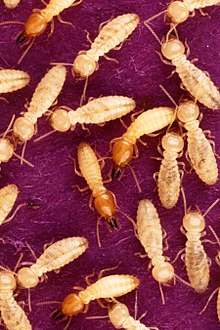| Formosan termite | |
|---|---|

| |
| Scientific classification | |
| Domain: | Eukaryota |
| Kingdom: | Animalia |
| Phylum: | Arthropoda |
| Class: | Insecta |
| Order: | Blattodea |
| Infraorder: | Isoptera |
| Family: | Rhinotermitidae |
| Genus: | Coptotermes |
| Species: | C. formosanus
|
| Binomial name | |
| Coptotermes formosanus Shiraki, 1909
| |
| Synonyms | |
| |
The Formosan termite (Coptotermes formosanus) is a species of termite local to southern China and introduced to Taiwan (formerly known as Formosa, where it gets its name), Japan, South Africa, Sri Lanka,[1] Hawaii, and the continental United States.
The Formosan termite is often nicknamed the super-termite because of its destructive habits due to the large size of its colonies and its ability to consume wood at a rapid rate. Populations of these termites have become large enough to appear on New Orleans' weather radars.[2]
A mature Formosan colony can consume as much as 13 ounces of wood a day (about 400 g) and can severely damage a structure in as little as three months.
Formosan termites infest a wide variety of structures (including boats and high-rise condominiums) and can damage trees. In the United States, along with another species, Coptotermes gestroi, introduced from Southeast Asia, they are responsible for tremendous damage to property resulting in large treatment and repair costs.
- ^ "An annotated checklist of termites (Isoptera) from Sri Lanka". National Science Foundation. Retrieved 15 February 2017.
- ^ "Swarm of termites shows up as cloud on weather radar". UPI. Retrieved 2022-10-08.